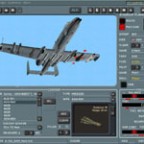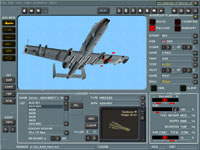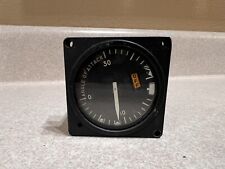An Honorable Ancestry
(continued)
One of the greatest names in sim development at that time was the venerable Jane’s/Electronic Arts franchise. Led by sim pioneer Andy Hollis, the EA team was responsible for some of the greatest icons of simulated combat aviation. Titles like Longbow and Longbow 2, which made a power of Tsuyoshi Kawahito (who would go on to fame as the designer of the classic European Air War), F-15, and its sequel, F/A-18, made this house the Very Last Word in modern combat jet simulations for the latter half of the 1990s. Its reputation was made in a now-dead genre: the single-aircraft study, what we now call the “hardcore” combat sim. The formula is simple. Take one well-known and well-loved aircraft, and model it in excruciatingly loving detail. Set it in a realistic world with realistic physics, and give it a mission editor and campaign to allow simmers to step out of the everyday hum-drum world and into the exciting challenge of being a combat jet pilot! To give us the fantasy of being able to Strap On The Real Thing, like they did in the movie Independence Day, and go lay a smack down on the bad guys!
Matt Wagner worked for EA. Along with development greats Chris Martin and Scott Elson, Wagner stepped out of obscurity into the fast-paced world of sim development with a legendary team of game designers. Wagner, however, came out of the ranks of flying simmers. In the community, he was well known for his articles on simulated combat. In the Flanker world, Matt was “one of us.” His articles, written for his online squadron, on the Russian Zhuk radars are still a must-read today. With Martin and Elson, Wagner was one of the driving forces behind Jane’s F/A-18, still the pinnacle of naval jet-combat simulation.  One of the only two sims to include the participation of women in large scale (the other being Falcon 4.0), F/A-18 broke ground in many other ways as well. It was the first to feature a fully-clickable, all-glass 3D cockpit. Its flame effects were, and are, among the best animation efforts in the whole history of simulated combat aviation. It had clouds, and animated water, a simming first. Shooting three-wire traps in F/A-18 onto a Nimitz-class carrier meant coming down the pipe to a deck moving in three dimensions! It gave a simulated flying experience so realistic, a real Navy Hornet pilot testing for EA reported that a night-trap evoked the same physical stress responses in him that a real landing would. It represented the mother-lode in AI and flight physics for Jane’s/EA, and it was the last true simulation that house would ever release.
One of the only two sims to include the participation of women in large scale (the other being Falcon 4.0), F/A-18 broke ground in many other ways as well. It was the first to feature a fully-clickable, all-glass 3D cockpit. Its flame effects were, and are, among the best animation efforts in the whole history of simulated combat aviation. It had clouds, and animated water, a simming first. Shooting three-wire traps in F/A-18 onto a Nimitz-class carrier meant coming down the pipe to a deck moving in three dimensions! It gave a simulated flying experience so realistic, a real Navy Hornet pilot testing for EA reported that a night-trap evoked the same physical stress responses in him that a real landing would. It represented the mother-lode in AI and flight physics for Jane’s/EA, and it was the last true simulation that house would ever release.
Jane’s/EA’s last study sim in development following F/A-18 was scheduled to be a look at the A-10 Thunderbolt II, Republic’s answer to the 1970s U.S. Air Force competition to produce what amounted to a modern-day Sturmovik, a dedicated tank-killer for the Fulda Gap, NATO’s great nightmare of the Cold War. The airplane the Air Force didn’t want, one with no sex appeal at all, slow and steady, a long-loitering replacement for the A-1 Skyraider of Vietnam fame that has one mission: Support The Troops. Its success stunned combat aviation. It’s a flying gun, its GAU-8 30mm cannon firing 30mm depleted-uranium slugs that contemporary pilot Andy Bush describes as accurate as aiming a laser. Ground pounders love it. And it hadn’t been looked at in sim-dom since Activison’s A-10 Cuba!, back before 3d acceleration was even invented. And simmers everywhere anticipated mightily. It was the one we all wanted; air-to-mud is overwhelmingly the choice of simulated combat aviators-who doesn’t like blowing things up? It was the one project Matt Wagner reallywanted to do.
Right up to the day the rug was yanked out from under his feet.
Jane’s/EA’s implosion at the end of the 1990s slammed the door shut on what would, from all accounts, have been another simming legend-in-the-making. Simmers mourned over the released development screenshots showing what looked to be one of the most detailed sims of all time, that would never see the light of day. And we thought that close air support would never find a modern sim home.
Until Carl Norman had a problem.
How many of you readers remember Tim Goodlett? During the combat flight heyday of the late ‘90s, Tim, a really nice and talented dev guru, got involved with the fiasco that ultimately spelled the Bitter End for MicroProse as a development house. Gunship! was another title with a fanatical following that was then as highly anticipated as LOMAC is today. But the Game Gods at MPS did a sim-light dome decree. And Goodlett was dead in sim-dom’s crosshairs when MPS released Gunship! to overwhelming disappointment. Among the compromises Goodlett was forced to make, and later, defend, were things such as the hated “air-starts” that started missions with the player in flight and tiny, generic maps. Though a fun play (and only now coming into its own as a precursor to today’s do-it-all simulation titles like IL-2 Sturmovik), MPS underestimated the certain backlash from turning hard-core helo simmers’ version of Flanker into sim lite. Gunship! flopped. MPS shut down not long after. Goodlett, at loose ends, was hired by SSI, then under new ownership.
By this time, the Norman vision for Su-25 had morphed into Flanker: Attack!, an all-new sim intended to build on the Flanker legacy. WithFlanker 2.51 as lead-in, FA was intended to add the Su-39 and A-10 to the Flanker family. Goodlett came aboard to assist in development. And sim-dom recoiled in horror. Unjustly laying blame for the Gunship! fiasco at Goodlett’s feet, the simming community rose en masse in protest, flooding SSI’s corporate Flanker forums with abuse, threats, and dire predictions of woe, pestilence, and disease. I was a regular poster on the Flanker boards then and let me tell you, it was like watching a lynch mob in slow motion. It wasn’t long before Flanker fans had a new face come aboard to shepherd us into The Promised Land: Matt Wagner.
 His hiring was a Norman master-stroke. In one fell swoop, oil was poured upon the troubled waters and peace restored to sim-dom. Flanker 2.51 came out to rave reviews, mine included (I was writing for WomenGamersat the time). Simmers could see the changes in progress. Great things were in store. A new name was coined for the genre’s new sheriff,LOMAC, and its planeset was shaken up a time or two. Finally, Wagner had a chance to put paid to the Jane’s A-10 abortion, and give combat simmers what they had wanted for years. Now, the Norman vision included the three aircraft that dominated Flanker’s last iteration (Su-27P, Su-33, MiG-29), plus three highly anticipated and rarely if ever simmed newcomers: the A-10, the aforementioned Su-25, and…the F-15C American Eagle. The world’s most beloved modern air-superiority fighter; yes, the Jack Armstrong of combat aviation was also coming to a computer near us. The simulation nation applauded. And the eager anticipation began in earnest.
His hiring was a Norman master-stroke. In one fell swoop, oil was poured upon the troubled waters and peace restored to sim-dom. Flanker 2.51 came out to rave reviews, mine included (I was writing for WomenGamersat the time). Simmers could see the changes in progress. Great things were in store. A new name was coined for the genre’s new sheriff,LOMAC, and its planeset was shaken up a time or two. Finally, Wagner had a chance to put paid to the Jane’s A-10 abortion, and give combat simmers what they had wanted for years. Now, the Norman vision included the three aircraft that dominated Flanker’s last iteration (Su-27P, Su-33, MiG-29), plus three highly anticipated and rarely if ever simmed newcomers: the A-10, the aforementioned Su-25, and…the F-15C American Eagle. The world’s most beloved modern air-superiority fighter; yes, the Jack Armstrong of combat aviation was also coming to a computer near us. The simulation nation applauded. And the eager anticipation began in earnest.
And the work began in earnest. Flanker masterminds Valery Blazhnov and Igor Tishin and their Russian band of brothers put keyboard to compiler and began the long slog through Flanker’s legacy code in search of Nirvana. And we’ve had bumps along the road; most importantly, the acquisition of SSI by entertainment giant Ubisoft, and shortly after, the temporary loss to the LOMAC team of its very heart and soul: Carl Norman, who left Ubi under mysterious circumstances some time before the title’s release. Gladly, Nick Grey and The Fighter Collection, that most august group that have been Flanker’s power-behind-the-throne since almost the very beginning, intervened and Norman is now their Consultant to Eagle Dynamics, advising the peerless team as it worked toward its final goal. Which is in my hot little paws right now. Let’s take a peek.

The Lock On Design Team
Warning: I will not review the multiplay aspects of LOMAC; I am not an online flier anymore and most simulated combat aviators fly solo-play anyway. SimHQ intends to do a separate article on multiplayer, and if you’re an online flier, one of the multiplay gurus here with detailed knowledge of those aspects will step up and get you into those aspects. LOMAC is designed with multiplay in mind, and supports both head-to-head and cooperative multiplay. As far as I know, the beta testers have not had serious issues with this and it is similar in most respects to that found in Flanker 2.5. Read this thread to learn more about multiplayer and LOMAC.
Another warning: If I sound a little less than objective, it’s true. As I said above, I’ve been a Flanker convert since the 1.5 title was first released. I love the series, and to me LOMAC is more Flanker 3 than a standalone game of a new dynasty. Virtual “Flankerites” like me, though, are the base on which LOMAC will have to build to be a success. If I’m disappointed and turned off, the Carl Norman Plan will fail. I’m most pleased overall, though, and you will see why as we stroll through the wonderful world that is LOMAC.













